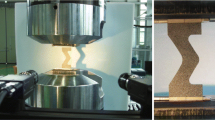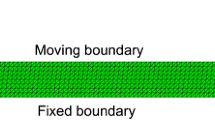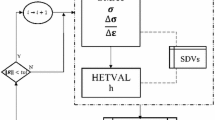Abstract
Local strain data obtained throughout the entire weld region encompassing both the weld nugget and heat affected zones (HAZs) are processed using two methodologies, uniform stress and virtual fields, to estimate specific heterogeneous material properties throughout the weld zone. Results indicate that (a) the heterogeneous stress–strain behavior obtained by using a relatively simple virtual fields model offers a theoretically sound approach for modeling stress–strain behavior in heterogeneous materials, (b) the local stress–strain results obtained using both a uniform stress assumption and a simplified uniaxial virtual fields model are in good agreement for strains ɛ xx < 0.025, (c) the weld nugget region has a higher hardening coefficient, higher initial yield stress and a higher hardening exponent, consistent with the fact that the steel weld is overmatched and (d) for ɛ xx > 0.025, strain localization occurs in the HAZ region of the specimen, resulting in necking and structural effects that complicate the extraction of local stress strain behavior using either of the relatively simple models.












Similar content being viewed by others
Notes
Similar results were obtained with both weld specimens. Hence, results are only reported for one of the experiments.
The translation stage is used to move the camera parallel to the specimen surface to center the region of interest in the field of view during the applied loading process.
To minimize out-of-plane motion effects, the camera is placed approximately 1.5 m from the specimen surface.
In this work, N = 5, where N is the number of displacement data points in each direction. Thus, each 5 × 5 displacement sub-array is selected by moving over one subset spacing (five pixels in this work) and selecting a new data set centered about the new mid-point. Since N = 5, the process gives a spatial resolution of 25 × 25 pixels for the strain estimates.
In-plane bending is more likely in welded specimens undergoing elastic-plastic response because the material response generally is asymmetric relative to the loading axis.
Increasing the number of measurements (N and M) improves parameter estimation. When using DIC, each data point corresponds to a correlation subset. Though overlapping subsets will increase data density, limited additional information is obtained when performing the matching process in this manner. Overlapping subsets will tend to smooth out local variations and transitions.
The decision regarding weld zone separation was based on a combination of (a) etching of weld cross-sections to clearly delineate differences in microstructure and (b) previous experimental evidence that showed marked differences in strain levels within specific weld zone regions. Though more (less) weld zones could be defined, the choice used in this study is believed to be appropriate for the application.
The strain field shown is based on 250 × 75 values obtained from the measured displacement field at each time.
Pre-smoothing is not used since the least squares solution process defined in equation (13) will perform the smoothing process when estimating the material properties.
The cost function defined in equation (18) is minimized in 3,800 iterations with the Nelder–Mead approach. Convergence requires 90 min on a PC that uses a 1.4 GHz Pentium M processor.
References
Lockwood WD, Reynolds AP (2003) Simulation of the global response of a friction stir weld using local constitutive behavior. Mater Sci Eng A V3391–2:35–42.
Peters WH, Ranson WF (1981) Digital imaging techniques in experimental stress analysis. Opt Eng 213:427–432.
Sutton MA, Wolters WJ, Peters WH, Ranson WF, McNeill SR (1983) Determination of displacements using an improved digital correlation method. Image Vis Comput 13:133–139.
Peters WH, He Z-H, Sutton MA, Ranson WF (1984) Two-dimensional fluid velocity measurements by use of digital speckle correlation techniques. Exp Mech 242:117–121.
Anderson J, Peters WH, Sutton MA, Ranson WF, Chu TC (1984) Application of digital correlation methods to rigid body mechanics. Opt Eng 226:238–743.
Chu TC, Ranson WF, Sutton MA, Peters WH (1985) Applications of digital image correlation techniques to experimental mechanics. Exp Mech 253:232–245.
Sutton MA, McNeill SR, Jang J, Babai M (1988) The effects of subpixel image restoration on digital correlation error estimates. Opt Eng 273:173–175.
Sutton MA, Cheng M, McNeill SR, Chao YJ, Peters WH (1988) Application of an optimized digital correlation method to planar deformation analysis. Image Vis Comput 43:143–150.
Sutton MA, Bruck HA, McNeill SR (1989) Determination of deformations using digital correlation with the Newton–Raphson method for partial differential corrections. Exp Mech 293:261–267.
Sutton MA, Bruck HA, Chae TL, Turner JL (1990) Development of a computer vision methodology for the analysis of surface deformations in magnified images. ASTM STP-1094; MICON-90. Advances in video technology for micro-structural evaluation of materials 109–134.
VIC2D, Correlated Solutions Incorporated, 120 Kaminer Way, Parkway Suite A, Columbia, SC 29210 www.correlatedsolutions.com.
Schreier H, Braasch J, Sutton MA (2000) On systematic errors in digital image correlation. Opt Eng 3911:2915–2921.
Schreier HW, Sutton MA (2002) Effect of higher order displacement fields on digital image correlation displacement component estimates. Int J Exp Mech 423:303–311.
Lagattu F, Brillaud J, Lafarie-Frenot MC (2004) High strain gradient measurements by using digital image correlation technique. Mater Charact 53:17–28.
Lockwood WD, Tomaz B, Reynolds AP (2002) Mechanical response of friction stir welded AA2024: experiment and modeling. Mater Sci Eng A323:348–353.
Reynolds AP, Duvall F (1999) Welding J 7810:355s–360s.
Adeeb SM, Horsley D, Yan J-H, Sutton MA, Reynolds AP. Local stress–strain response of an axial x100 girth weld under tensile loading using digital image correlation. Proceedings of the 2006 International Pipeline Conference, September 25–29, Calgary, Alberta, Canada, IPC2006-10330.
Grédiac M (1989) Principe des travaux virtuels et identification. C R Acad Sci 309:1–5.
Grédiac M, Toussaint E, Pierron F (2002) Special virtual fields for the direct identification of material parameters with the virtual fields method. 1- Principle and definition. Int J Solids Struct 3910:2691–2706.
Avril S, Pierron F (2007) General framework for the identification of constitutive parameters from full-field measurements in linear elasticity. Int J Solids Struct 44:4978. 5002.
Grédiac M, Pierron F, Avril S, Toussaint E (2006) The virtual fields method for extracting constitutive parameters from full-field measurements: a review. Strain 42:233–253.
Pannier Y, Avril S, Rotinat R, Pierron F (2006) Identification of elasto-plastic constitutive parameters from statically undetermined tests using the virtual fields method. Exp Mech 466:235–255.
Grédiac M, Pierron F (2006) Applying the virtual field method to the identification of elasto-plastic constitutive parameters. Int J Plast 22:602–627.
Avril S, Pierron F, Yan J, Sutton MA (2007) Identification of viscoplastic parameters using DIC and the virtual fields method. Proceedings of the SEM Conference and Exposition, Springfield, USA.
Meuwissen MHH, Oomens CWJ, Baaijens FPT, Petterson R, Janssen JD (1998) Determination of the elasto-plastic properties of aluminium using a mixed numerical-experimental method. J Mater Process Technol 75:204–211.
Kajberg J, Wikman B (2007) Viscoplastic parameter estimation by high strain-rate experiments and inverse modeling—speckle measurements and high-speed photography. Int J Solids Struct 44:145–164.
Kajberg J, Lindkvist G (2004) Characterisation of materials subjected to large strains by inverse modelling based on in-plane displacement fields. Int J Solids Struct 41:3439–3459.
Hart JD, Powell GH, Zulfigar N (1996) A material model for pipeline steels. International Pipeline Conference ASME 2:613–627.
Acknowledgements
The authors gratefully acknowledge the support of (a) the Army Research Office and Dr. Bruce Lamattina through W911NF-06-1-0216, (b) Dr. Stephen Smith and NASA Langley under Grant NASA-NRA-NNX07AB46A and (c) General Motors and Dr. Pablo Zavattieri through both contractual support ND0144200 and an unrestricted gift 002259249. The technical assistance provided by Prof. Xiaomin Deng in the Department of Mechanical Engineering at the University of South Carolina and Dr. Hubert Schreier and Correlated Solutions Incorporated for supporting this effort through modifications to their software, VIC-2D, for our use is deeply appreciated.
Author information
Authors and Affiliations
Corresponding author
Rights and permissions
About this article
Cite this article
Sutton, M.A., Yan, J.H., Avril, S. et al. Identification of Heterogeneous Constitutive Parameters in a Welded Specimen: Uniform Stress and Virtual Fields Methods for Material Property Estimation. Exp Mech 48, 451–464 (2008). https://doi.org/10.1007/s11340-008-9132-6
Received:
Accepted:
Published:
Issue Date:
DOI: https://doi.org/10.1007/s11340-008-9132-6




